Cave Myths
Why taking pictures is forbidden...

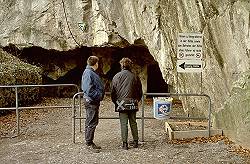
In many caves taking pictures is forbidden. The explanation, that other cave visitors are annoyed by the flash is easy to understand. Another good reason is that taking pictures takes time and tends to break up the group. And the flash disturbs bats, so in some countries it is forbidden by law, to take pictures of bats.
But while this sounds good, it is not true. The true reason, why taking pictures is forbidden, is called copyright infringement. The cave owner wants to make some bucks by selling the right to publish images of his cave. The owner basically thinks he owns the right on pictures of his cave. Unfortunately this is not true, as most countries have only two related laws, one on copyright, which regulates the use of the pictures for the photographer. Another which describes the rights and duties of the cave owner, which could be called "property rights". Both laws do not allow restricting the use of pictures someone else makes. The only way to do this is to prohibit photography completely, using the property rights, then all legal pictures are made by him and are protected by copyright laws. This is lawyer logic, but this is the way it works!
Some cave owners think, they have to explain, why taking pictures is forbidden. But the copyright explanation could destroy their aura of being an altruistic protector of nature. So they invent really fantastic stories about cave destruction by flash.
Flash Make Plants Grow On The Speleothems
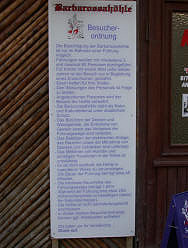
I heard this argument several times! Sounds good, doesn’t it? But think about it a bit more:
A seed of Audrey III, the killer tomato from space, astray in the cave, sits on the most beautiful speleothems of the cave!
It ignores the electric light, burning at least 8 hours every day.
But one day, the bad photographer visits the cave, taking pictures with his big flash.
Ultraviolett light hits the seed, it grows in some seconds, infests the speleothems and then starts to attack some careless cave visitors....

Okay, that was a joke! But the scientific explanation is rather simple: of course, the flash is very bright and contains a lot of ultraviolet light. But the plants are not really able to use this energy, as the process of photosynthesis goes rather slowly. The continuous illumination by the cave lights is the problem, even if the tour guide turns them on and off as the tour moves through the cave. A few hours per day are enough for the growth of lampenflora, the microsecond of a flash not.
Taking Pictures is Forbidden by Law
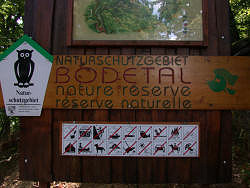
Often someone else is blamed, why photography is forbidden. In most countries, there is an authority observing the safety of underground operations, like show mines and show caves. They make regulations, for the brightness of the light, the construction of paths or the existence of a secondary light system for emergencies.
I never heard of any authority which prohibits photography in caves or mines neither with nor without flash. In most cases they would be astonished if you told them that they are made responsible for the ban.
Flashlight Blinds the Visitors for up to 15 Minutes
Some caves argue, the flash was much brighter in the darkness of the cave (which is true) and so the eyes are blinded and need some time to recover, probably up to 15 minutes (which is not true). But this is perilous as people are not able to see the path during this time, and so they might stumble and hurt themselves.
I have to admit that flashing light into the eyes is not really fun, especially if the eyes had previously become accustomed to the dim cave and the pupils are wide open. But it doesn’t harm the eye, and it only takes a few seconds to recover. Otherwise, photographers all over the world would be sued for destroying their clients’ eyesight!
And it was pretty funny, that right after this explanation there was a spot where the tour group was pictured (using flash) and the picture was sold at the exit.
Actually the guide was not very happy when most of our group (mostly cavers) started to run around with closed eyes and stretched out hands, crying "help me, I am blind for 15 minutes...".

The Flash Disturbs the Bats
Sounds logical, but is actually not the truth! In some countries it is forbidden by law to take photographs of bats, because of exactly this reason. But although we appreciate any attempt to protect cave animals, we must confess that taking pictures with flash does not harm bats in any way. They just do not really like it, like we do not like it either. Actually, two simple questions might explain this:
- If bats are disturbed by flashing light, are they not disturbed by cave lighting and noise during daytime sleeping hours? Such an argument can only mean closing the show cave completely.
- Why do the bats seek out this part of the cave to sleep? Most show caves are much larger than the show part, often only a tiny fraction is developed. But maybe the bats like to grumble and are just looking for a reason to do so. They are just quarrelsome bats.
Bats are not dependent on their eyes, they orientate mainly using sonar. So they don’t see very well, and they are not blinded by the flash. They are blinded by ultrasound. In fact, the noise that the flash makes when charging, which is almost inaudible to us, is much more disturbing to the animals than the flash of light.
Let’s get one thing straight: protecting bats is a good thing, as is any kind of environmental protection, but using the poor bats as an excuse, they don’t deserve that.
The Use Of Cameras Seriously Damages Calcite Formations
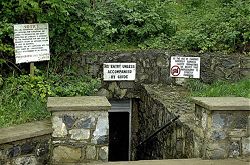
(© Mathias J. Duckeck)
All above explanations are based on the flashlight.
This is a tactical error of the cave owners, as this gives the cave visitor a very good argument, if he is able to take pictures without flash: if taking pictures is forbidden only because of the flash, taking pictures without flash is obviously allowed!
Fortunately there are today digital cameras with high sensibility and the possibility to adapt on artificial light....

To avoid this discussion
 Mitchelstown Cave
has invented the strangest story about the dangers of taking pictures: "the use of cameras seriously damages calcite formations"!
Mitchelstown Cave
has invented the strangest story about the dangers of taking pictures: "the use of cameras seriously damages calcite formations"!
Taking pictures damages dripstones!
Now I know, not light, flashlight or dust from the visitors is the problem.
Every image you take, takes away some of the glittering glance of the stalagmite.
Take the image of the stalagmite and take it home, captured in your Japanese camera.
Bugs Bunny cartoons of reading away the text in newspapers come true!
 We are lucky that there are such altruistic cave owners, doing their best to preserve the wonders of nature!
We are lucky that there are such altruistic cave owners, doing their best to preserve the wonders of nature!
The new owner told me lately, he removed the above sign, so this image is a historic document now.
It is still forbidden to take pictures, but it is really admirable that he now tells the true reason: copyright infringement.
On one hand, I appreciate this honesty very much, but on the other hand: the old explanation was much funnier!

The Use Of Cameras Seriously Damages Cave Paintings
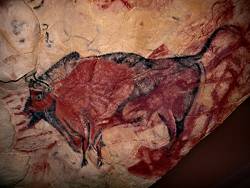
There is a special group of caves which are called
 Painted Cave,
and they have paintings from the stone age on the walls.
Those paints have pigments which actually do decompose from UV light.
This was the reason why most painted caves actually forbid photography.
However, the explanation is extremely bogus.
In reality, the destruction caused by temperature changes, humidity, dust and fungi introduced by visitors, and above all by the lampenflora caused by the lighting, is a thousand times worse.
Painted Cave,
and they have paintings from the stone age on the walls.
Those paints have pigments which actually do decompose from UV light.
This was the reason why most painted caves actually forbid photography.
However, the explanation is extremely bogus.
In reality, the destruction caused by temperature changes, humidity, dust and fungi introduced by visitors, and above all by the lampenflora caused by the lighting, is a thousand times worse.
Yes, they reduce light, yes they restrict the numbers of allowed visits, yes, they install airtight doors and air locks to control the cave climate. Buy why is taking photos without flash forbidden? If you check the website of the French Ministry of Culture, which manages all the French painted caves, they tell you the reason: they sell pictures of the cave at a steep price.
And another fact, which makes clear that prohibiting photography does not protect the images: it is also forbidden in replicas. Most caves are not accessible, only replicas are accessible. Nevertheless, taking pictures of the replicas is prohibited. Even if the flash damages the images, they are only copies, and it’s easily possible to create another replica. Actually this is done regularly anyway, the current replica of Lascaux Cave is Lascaux IV, the fourth replica. It’s the official name! And still it is forbidden to take pictures without a flash.
There are a few notable exceptions though, for example, the Altamira replica in the Deutsches Museum in Munich, Germany or the Museum
 Pavilon Anthropos
in Brno, Czech Republic.
Pavilon Anthropos
in Brno, Czech Republic.
Taking Pictures Allowed
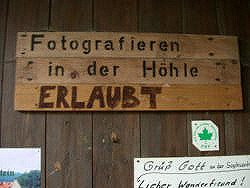
There were once such prudent cave operators who took care of their cave and protected nature without bullying the visitors! A few simple cave protection rules can be quickly explained and reasons given, so they make sense. And yet the opposite seems to be on the rise: on the one hand, nature is abused as a sporting tool and destroyed with extreme sports, on the other hand, people who treat nature with care are harassed, up to and including nonsensical coercive measures.
Example 1: the cave tenant who so laudably allowed photography (see picture left) was replaced by the owner with a new, dynamic tenant.
The first thing the latter did was to literally lock the cave in jail.
The entire entrance area was closed off with an iron grille, which looks like a prison in the Wild West.
And the
 Sophien Cave
sits behind bars.
Sophien Cave
sits behind bars.
Example 2: The following story shows that it has become really rare, that taking pictures is allowed:
A caving club returns to southern Germany after a week-long excursion to the Harz mountains in northern Germany.
Two or three visits to show caves a day and not a single one where photography was allowed.
On the return trip there is a break with a visit of
 Marienglashöhle
in Thuringia, the last visit of this trip.
One participant says: "Now you were not allowed to take pictures in any cave.
I’ll leave my camera in the bus."
At the beginning of the tour the guide welcomes us with the words:
"Welcome to the Marienglas Cave! Photography is allowed here!"
A desperate cry from the back row followed...
Marienglashöhle
in Thuringia, the last visit of this trip.
One participant says: "Now you were not allowed to take pictures in any cave.
I’ll leave my camera in the bus."
At the beginning of the tour the guide welcomes us with the words:
"Welcome to the Marienglas Cave! Photography is allowed here!"
A desperate cry from the back row followed...
 Why Photography Not Allowed in Cave? (visited: 27-OCT-2021)
Why Photography Not Allowed in Cave? (visited: 27-OCT-2021)
 Index
Index Topics
Topics Hierarchical
Hierarchical Countries
Countries Maps
Maps Search
Search